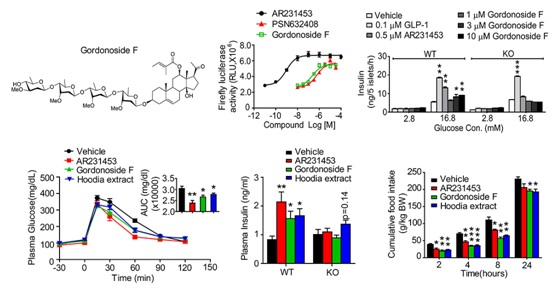SIMM and SIOC discover molecular mechanism of Hoodia gordonii appetite suppression
Update time:Author:
Recently, researchers from Shanghai Institute of Materia Medica (SIMM) and Shanghai Institute of Organic Chemistry (SIOC) discovered the molecular mechanism of the appetite suppression effect of a popular ‘weight loss’ herb Hoodia gordonii. The findings were published on line in Sep. 22, 2014 in the Proceedings of the National Academy of Sciences of the United States of America.
Hoodia gordonii, a cactiform found in the Kalahari Deseret in South Africa, has been used for thousands of years by Xhomani Bushmen as an anorexant and has been proposed as a new agent for the management of body weight. However, its in vivo targets and molecular mechanisms remain elusive. The development of Hoodia and P57, the purported active ingredient, has been problematic due to controversy in intellectual property rights and limited natural resources.
Researchers found that Gordonoside F, a steroid glycoside isolated from Hoodia, but not the widely known P57, activates specifically GPR119, a G protein-coupled receptor and a potential drug target for metabolic disorders. Gordonoside F promotes GLP-1 and insulin secretion both in vitro and in vivo, and reduces food intake in mice. These effects are mediated by GPR119 since GPR119 knockout prevents the therapeutic effects of Gordonoside F. Interestingly,the appetite-suppressing effect of Hoodia extract was also partially blocked by GPR119 knockout. These discoveries provide a promising opportunity to develop new drugs in treating metabolic diseases.
This work was supervised by Profs. XIE Xin and YU Biao. The first authors are Drs. Shuyong Zhang (biology part) and Yuyong Ma(chemistry part). This work was supported by grants from Ministry of Science and Technology of China, National Natural Science Foundation of China and Shanghai Commission of Science and Technology.
Link to the article:http://www.pnas.org/content/early/2014/09/16/1324130111.full.pdf+html





